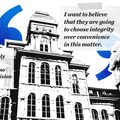Guest Column: Students have a role in SU’s carbon reduction plan

In the modern gig economy, hard work and dedication don’t equal success. We must develop a deeper awareness of how economic disparities limit access to opportunities, forcing people to work side hustles, our writer says. Avery Magee | Asst. Photo Editor
Get the latest Syracuse news delivered right to your inbox.
Subscribe to our newsletter here.
In February, Chancellor Kent Syverud unveiled an ambitious housing strategy of replacing Marion and Kimmel halls with a 450‑plus‑bed facility on Ostrom Avenue.
The initial steps of the plan involved transforming the former Sheraton Syracuse University Hotel and Conference Center into Orange Hall to expand student housing. This transition marks the start of Syracuse University’s rapid and determined housing strategy. Speed, however, isn’t the only metric that matters.
Last April, the university’s refreshed Climate Action Plan expedited the deadline for carbon neutrality from 2040 to 2032. The plan relies heavily on modernizing building machines, electrification and carbon‑sequestering materials to reach net-zero status, which means that total carbon emissions created by the university are equal to the amount of emissions removed from the atmosphere.
As these two missions collide, the university must choose how it proceeds to fulfill hopes of both expanding housing and reaching net zero goals. But students also bear a lot of the responsibility. Our decisions are the real actions impacting SU’s future as a model for environmentally conscious living.
We can best aid the university’s pursuit of this status by reforming small daily habits that cause energy overconsumption. Change starts in the dorms we already occupy.
Residence halls consume energy constantly. National benchmarking studies show that dormitories often use 80 to 100 kWh per square foot annually — double the median for academic buildings.
Studying with larger groups in campus libraries can limit mass amounts of energy usage accounted for by independent study. Bird Library and Carnegie Library in particular have study rooms with motion-detecting lights to ensure light doesn’t go to waste. Not only could this enhance community togetherness, but it also greatly reduces energy consumption.

Cole Ross| Digital Design Director
As the university invests in building renovations to ensure its students are supported during Syracuse’s dramatic shifts in weather, meeting SU’s initiative halfway can hugley reduce large energy costs. Beginning on South Campus with the Department of Energy, SU began modernizing mechanical systems in charge of cooling, heating and insulation.
We can support these renovations by simply being mindful in how we use our doors and windows. There are easy measures, like ensuring they’re closed when heating or cooling is on, that we can take to do our part in SU’s mission.
The university has published its own revitalized standards, setting a guideline for how all campus buildings will be improved to get closer to net zero. These improvements include modernized heating and cooling systems, reinforced entryways, windows and installation of more efficient building appliances such as lights, computers and elevators.
Around 10% of all electricity used worldwide is phantom energy — electricity consumed by idle devices. Charging phones, laptops and leaving dorm appliances plugged in silently contributes to unnecessary energy overconsumption.
But technology alone won’t eliminate all the obstacles the university faces to fulfilling its goals. There needs to be real change integrated into the way SU students live. Collaborating with the student body will yield much more prominent changes to the culture around energy consumption.
College campuses rely so heavily on the student body for change, and it’s paramount that students become involved in this step to saving the planet. Attending a sustainability workshop reading up on the current climate action plans and making adjustments in your routines can make a lasting impact.
With the use of lobby‑level energy dashboards showing real‑time electricity and water use, students can become partners in the commitment to sustainable living. Syverud’s housing plan states that “modern, comfortable housing is key to student success.” Comfort and climate responsibility shouldn’t be mutually exclusive but symbiotic.
Well-designed windows and entryways will mean no more drafty winter nights. Improved indoor‑air‑quality standards will mean fewer colds during flu season. And an energy‑dashboard competition might even engage the student body in collective talks about sustainable living and public policy which will leave a larger impact beyond our campus. But all of these benefits rely entirely on the initiative of the student body.
The class of 2032 deserves to graduate from a campus that was conscious of their climate future and built a lasting legacy of sustainability. If we seize this moment, the opening of these new dorms will signify not just school pride but a national standard for sustainable campus living.
Jason Suin is a freshman majoring in Aerospace Engineering. He can be reached at jgsuin@syr.edu.






